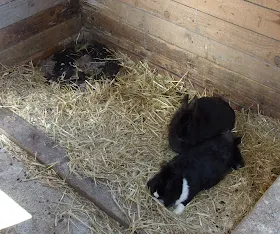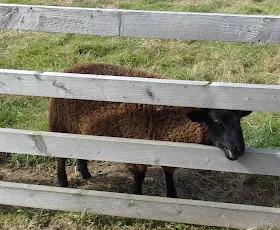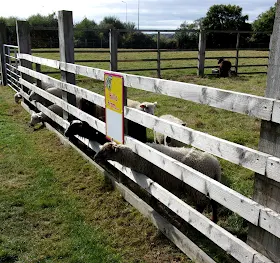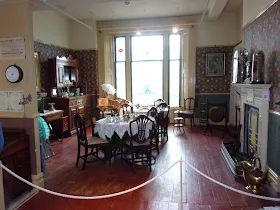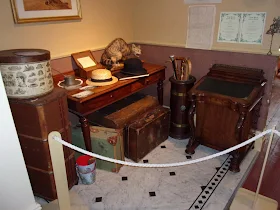Last autumn we went to see the Blackpool Illuminations, staying at Haven Cala Gran Holiday Park. It wasn't our first trip to Fleetwood, but this time we popped into the town quite regularly to pick up provisions, as it was nearer to where we were situated than Blackpool, eight miles down the road.
Here's my Blackpool Illuminations blog:-
We were in the Fylde area for a week, so made sure we took the time to relax (for once, rather than trying to fit too much in!) Farmer Parrs Animal World was right where we were staying, so we took a stroll over the road to see the animals.
You enter through the Fylde Country Life Heritage Centre, which is set up in 10,000 square feet of old farm buildings.
As well as machinery you get to see realistic recreations of shops, buildings and rooms; representing living, working and leisure.
Looking over the balcony and I was instantly reminded of a similar experience I had in The World of Country Life, in Exmouth, Devon. Here is my blog link if you'd like to take a look at that:-
The collection has been restored to working condition by the Fylde Country Life Preservation Society, which was formed in 1974 with the intention of promoting rural history in the area.
Of course, lavatorial little moi had to take a photo of the scene below, depicting a bloke on the privvy...😁
After setting up a permanent base for their exhibits in 1990, the society moved its collection to Farmer Parrs (I think they should have added an apostrophe there😉) in the late 1990s. A photo of a rustic khazi, minus an occupant...😁
The Parr family has a long tradition of farming; they have been working as farmers for generations and can be traced back to Inskip and Hornby, which are also in Lancashire. They moved to Fleetwood in 1951.
'Who're you callin' a bore?' said this chap.
'No, I said boar,' I replied!
Important events revolving around changes in industry have led to a need to diversify, as a lot has changed over the years, with some of Fleetwood's houses and schools now standing on land they used to farm. Here's a ram and the SuperDean's big great swede in the way...😁
The petting farm has been open for twenty years now; it originally started as a rare breed farm with 20 breeds of sheep and 11 of cattle, as well as donkeys, horses, ponies, goats, birds and unusual creatures such as emus, rheas, llamas and wild boar. The sheep were very friendly, and there's lots of reference on Farmer Parrs website regarding the fact that "EWE will love them!"
An inquisitive ram... The animals have changed over the years but still manage to delight.💓
And another inquisitive ram...
African Pygmy Goats, and they are known to be naughty animals...
Although loyal, they are mischievous, and have been known to escape from time to time!
A sitting duck, and apparently these are not that keen on water, unlike the wild variety that likes to live on their large ponds...
Farmer Parrs has a mixed assortment of chickens...
...Not to mention a cock...
The peacock didn't want to play ball and fan his tail for me...
And this bird just preferred to show me his bum!
Tortoises...
Guinea pig coming to say hi...
Rabbits snuggling down...
The best shot I could get of this ferret. Apparently they smell, but I wasn't close enough to find out exactly how much.😁
If my memory serves me correctly, then this fella is a pig, albeit one showing me his bum!
Oh deer!💓💓💓
Red deer are normally very shy, but these were friendly.😀
Interesting fact- it is a ruminant, which means it has an even number of toes on each hoof...
Alpacas originate from South America, and are famous for their fabulous coats.
The alpacas here live happily alongside llamas and sheep...
Falabella (miniature horses), horses and ponies live on the farm...
...As well as gorgeous donkeys, although if my memory serves me correctly, later one was being stubborn and didn't want to go back to his stable!
One of quite a few sheep...
...Here are several more...
This cow was having a rest...
Another cow, and the SuperDean very kindly said, 'There's one of your ilk over there...' Charming!
Turkeys...
The miniature donkeys are called Annie and Bobby.💓
This tram is apparently one of eight Centenary classic cars which were built in the 1980s. It was retired in 2012 and its interior is still the same. It was closed to the public when we were there, but you can see the advertisement for the farm on the outside.
Marsh Mill is a tower windmill dating from 1794, and was on our bus journey from the holiday park to Blackpool. As I live in London I don't often get to see windmills, so I just had to take this picture through the bus window.
I had to be be prepared with my camera and quick on the draw at the bus stop! The mill has been fully restored and is open to visitors, although we didn't go inside.
The mosaic flooring as you enter Fleetwood Museum, which has been at this site since 1991. I can find no reference to what the initials stand for, though- could it be ICP, which (in the context of export controls) means Internal Compliance Program? The building was originally the custom house.

The building is the oldest in the town and is a Grade II listed building dating from 1836. It was firstly the custom house, then in private ownership and named "Wyre Holm," and then the town hall before becoming the museum.
In The Story of Fleetwood section sit busts of Sir Peter Hesketh-Fleetwood (1801-1866), principal landowner and developer of Fleetwood and his architect, Decimus Burton (1800-1881).
View of the Promenade- Fleetwood, 1969, by Keith Sutton (a local artist). It depicts people enjoying the seaside whilst trawlers head out to sea.
As you enter one of the first things you see is the Victorian Dining Room section, with this atmospheric recreation of a boarding house dining room...
...Which includes period artefacts and a rather feral looking stuffed cat!
The main purpose of the museum is maritime history, and there is a section dedicated to Deep Sea Trawling. Here we have a poster of the kinds of fish caught, along with the style of trawlers used to catch them.
Inshore Fishing, and in this section we learnt about the local tradition of musseling, prawning, shrimping and cockling.
For some reason this brings to mind a lovely Sicilian pasta dish I ate at a restaurant many miles away in Littlehampton, some 20 years ago. It contained cockles and prawns, and I loved it so much that I recreated it at home!
Take a Deep Breath: The Story of Fisherman's Friend, and Fisherman's Friend cough remedies were created by local pharmacist, James Lofthouse, in 1865, and are still manufactured in the area. I remember eating the sweets as a kid, and they certainly pack a punch!
There is much to see in this museum, with sections called The Royal Naval Patrol Service, The Lifeboats and On The Docks. I've only honed in on just a taster. This beautiful khazi was manufactured locally...
This cabinet is dedicated to local government, and here we have the mayor in ceremonial dress...
This Lass Can: Stories of Fleetwood Women, and this outfit is emblazoned with the logos: Women's Trousers.This room celebrates women!😀
Salt Mining, and the Fleetwood Salt Company was established in 1883 to exploit the local salt field...
I'm not sure why the miner has a monkey on his shoulder, but he's cute so deserved a photograph!
"Harriet" is the name of the fishing smack on display in the Boat Hall, and I like the fishy sculpture facing her.😀
She was built in Fleetwood in 1893 and was rescued from Millom- a small Cumbrian coastal town- in 1998. As you can see, she's not in the best of conditions...
As part of the National Historic Fleet (a list of over 1,000 historic ships and vessels located in the United Kingdom) she is of cultural and heritage significance...
She's one of a few surviving fishing smacks (a type of traditional fishing boat popular in the 19th century) left in the UK.
After leaving the museum I took a photo of this nearby house simply because I loved the way the exterior's decorated.💗
The row of houses the museum stands along faces the seafront, and it was aforementioned Decimus Burton, a neo-classical architect, who designed the layout of the town, and its most prominent buildings, from 1836 until 1843.
Fleetwood was planned by High Sherriff and MP Peter Hesketh-Fleetwood, who intended his town to become a major port and a seaside resort aimed at the less affluent. Industry-wise, he envisioned the town becoming the main transfer point between the railway and steamers to Scotland.
This is the Upper Lighthouse (also known as Pharos, after Pharos of Alexandria in Egypt, which is one of the Seven Wonders of the Ancient World), was designed by Burton and opened in 1840.
The Beach Lighthouse was also designed by Burton, and also opened in 1840.This photo is a PDF- I got back to our accommodation and realised I'd omitted to take a photo of it. I'd planned on coming back the next day but, as the weather was squally (which it can be, up north in autumn), decided to chill out around the holiday park instead!
Unfortunately, the 1850s completion of the railway link from London to Scotland via Sharp Fell rendered the idea of Fleetwood as a transport hub obsolete. Hesketh-Fleetwood had run into serious financial difficulties, and the rise in popularity of neighbouring Blackpool as a seaside resort meant that Fleetwood's fortunes declined.
Fleetwood also has a very large indoor market which dates back to 1840. We make a point of visiting it whenever we're in Blackpool- it sells goods of many descriptions and I have been known to scoff a delicious Lancashire hotpot bought from one of the stalls.😁
The Fleetwood Memorial Clock commemorates the First World War.

Ferries to the Isle of Man used to run from Fleetwood (shame they still don't- I might have been tempted by a daytrip!) and a ferry still runs over to Knott End, over the River Wyre. We had planned on taking a trip, but were quite knackered and the weather wasn't great, so decided against it, and didn't manage to come back on our last day.
I'm sure I'll pop up to Fleetwood next time I'm in Blackpool- it's easily accessible via tram (it's at the end of the line.)
Until then...
TTFN
The Miss Elaineous.
.jpg)



















